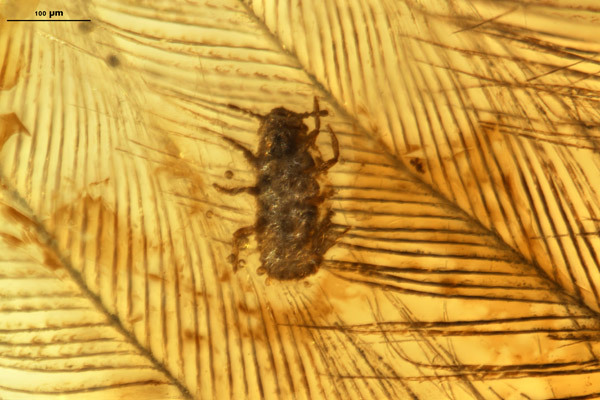- Paleontology: the beetle that pollinated flowers among dinosaurs
- Finding: Discover the oldest frog preserved in amber
Amber provides scientists with a unique tool to peek into the world millions of years before the appearance of the human being. Not only does it capture organisms almost instantaneously, but it also retains the interactions between them.
Thus, the finding of ten insect larvae, preserved together with two dinosaur feathers in fossilized resin, has allowed an international team of researchers to rebuild biological relationships that took place 100 million years ago.
The findings of their investigation, published Tuesday in Nature Communications , describe a species of extinct insect, which they have named Mesophthirus engeli and whose remains have been found in the province of Kachín, in northern Myanmar.
The markings on the feathers found next to the larvae coincide with those left by the current lice in the birds that parasitize. According to his discoverers, M. engeli had a shape very similar to that of modern lice, although his chewing organs were noticeably stronger.
"The first lice-like insects help us understand the evolution in that remote period: how they adapted their morphological features and their behavior to feed on feathers," explains Chungkun Shih, a researcher at the National Museum of Natural History at the Smithsonian Institute in Washington.
Scientists have found evidence of the existence of parasitic insects that fed on blood both in the Jurassic (between 201 million and 145 million years ago) and in the Cretaceous (between 145 million and 66 million years ago).
However, the origin and evolution of the first parasites that consume hair or feathers continues to awaken many unknowns. And finding remains of invertebrates that lived millions of years ago in a state of conservation that allows to specify their food source is extremely complex.
Witnesses of evolution
Lice are a very useful tool, not so much to recompose the puzzle of evolution, but to verify that the pieces fit together . It is a very specialized animal: each type parasites a single species and its anatomy adapts to each type of skin or plumage. This adaptation is so precise that when the host evolves, the louse also usually diversifies.
Those who live in the human head, for example, evolved from the chimpanzee louse, when the ancestors of both species separated, about five million years ago. However, the pubic louse in sapiens is related to the gorilla parasite, a species that diverged more than 12 million years ago.
In this way, the subspecies of lice reflect, in a way, the branches of family trees and kinship relationships in each family of animals.
Origin of the species In 2011, a study published in Biology Letters carried out the first reconstruction of the family tree of the lice, elaborated based on the genetic material of the current populations and that of two fossils trapped in amber that dated 44 and 100 million ago of years
Molecular analyzes allowed the authors to estimate that their origin dates back much further back in time than previously believed, and that the first hosts had to have been theropod dinosaurs, ancestors of the birds. Later, they could have inherited both the plumage and the parasites from the saurus.
"It is interesting to note that in that article the authors pointed out that lice appeared much earlier than previously thought and that the host of the first louse would have been a dinosaur, probably a theropod, one of the ancestors of birds," says Shih, Noting the coincidence between the works. "In our study we have identified an example of lice that itched and damaged dinosaur feathers in the middle Cretaceous (100 million years ago)."
Debate on birds and mammals
These findings bring light to the debate about the appearance and diversification of birds and mammals. A first hypothesis argues that both groups proliferated at the beginning of the Cretaceous (which began 145 million years ago) and that many of their lineages survived the cataclysm that ended the dinosaurs (65 million years ago). The opposite theory states that they could only have proliferated once the sauropsids disappeared.
The problem is that in this debate, DNA models and fossil records contradict each other: the chronology obtained from the genetic analysis of lice indicates early speciation and diversity prior to the impact of the asteroid 65 million years ago . Its defenders believe that the rupture of the former supercontinent Gondwana (about 120 million years ago) could open the door to a first great evolutionary diversification.
But the fossil record does not show that placental mammals expanded, in terms of number of species, until the end of Cretaceous 65 million ago, which suggests a direct relationship with the cataclysmic event that ended the dinosaurs.
Although, as Vincent Smith pointed out, the author of the work in Biology Letters " the lice are very old, before the end of the Cretaceous , and during all those years they had to have lived in something."
According to the criteria of The Trust Project
Know more- science
- Science and Health
Space19 + The Seville summit will break the record of investment in space
Journalism to combat bulos about the climate crisis
Paleontology The 'Homo sapiens' did not cause the extinction of Neanderthals

